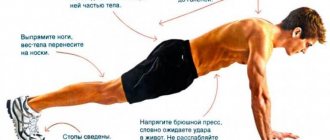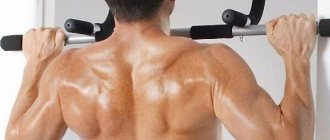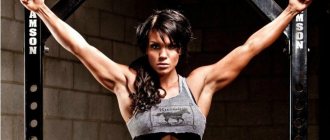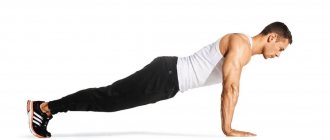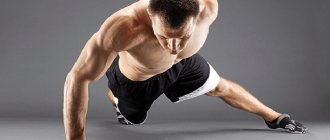Introduction[edit | edit code]
50 Pull-Ups in 7 Weeks
Everyone wants to be lean, strong and healthy, but how do you choose a training plan that will help you achieve the best results in the shortest possible time? The main problem for those who want to improve their physical fitness is, as a rule, not difficult exercises, but the lack of time for training.
For those overly busy people, we offer pull-ups, an incredibly effective exercise that can work your entire upper body in less than 20 minutes a day, 3 times a week. In addition, they will not require special training or expensive equipment from you. By following a progressive pull-up-based training program, you will strengthen and sculpt your arms, shoulders, back and abs. This book contains a detailed guide to running this wonderful program and many other useful information. It details the beneficial effects of pull-ups on the body, such as a significant increase in muscle endurance in the arms, upper and midsection, accelerated formation of lean muscle mass, and a sharp increase in metabolic rate necessary for burning excess fat.
RECORD PULL-UPS IN 1 MINUTE (MEN): 50
Jason Petzold (USA) June 20, 2009, Millington, Michigan
Matthew Bogdanovich (USA) November 12, 2009, Castro Valley, California
PULL-UPS RECORD IN 1 MINUTE (WOMEN): 37
Elicia Weber (USA) May 27, 2010, Claremont, Florida
I’ll repeat it again: 20 minutes a day, 3 times a week. Everyone wants their workouts to be simple and straightforward, take little time, and produce results almost immediately. If an exercise is too difficult to do or remember, then you simply won't do it. And if you don't see quick results, you will soon quit this program, just like all other fitness plans. Therefore, I declare with full responsibility that if you follow this program, you will immediately feel the results and quickly realize your dream of having a slim, strong and healthy body. Tested from my own experience.
How pull-ups changed my life[edit | edit code]
Pull-up... This one word, uttered in physical education class, is enough to scare any middle school student. Throughout my school years, I was terribly afraid of the day when we would have to pass the pull-up standards. I met the standards for abdominal exercises, push-ups, and even shuttle running, but I couldn’t do a pull-up on the horizontal bar even once.
For years, I was afraid to even think about trying to do pull-ups on the gym, and as I got older, I became even more afraid of doing pull-ups in the gym. I usually watched in admiration from the far corner of the room as tough guys performed amazing sets, and counted the reps without anyone noticing. I spied on them, as if possessed by some indecent passion. From time to time I still tried to grab the horizontal bar and pull myself up at least once. But, convinced that I was not able to reach my chin to the bar, I hastened to pretend that I was just stretching. You can’t tell me how passionately I dreamed of performing a dozen full pull-ups in front of the entire audience. But at that time I could not even imagine that I would ever be able to do this.
Now I'm almost 40 years old, and every workout I do a total of 50 to 100 pull-ups.
How did I do this? I gave up daydreaming and got serious about a progressive training program that radically changed my figure and my life. This book was created directly on the basis of this program. It includes training plans for people of all ages, genders and ability levels - for anyone who is serious about increasing their level of fitness.
Push-up variations
- Classic push-ups Get into a plank position. The pelvis should not collapse, the palms should be under the shoulders. Then bend your elbows and lower your chest down until your shoulders are level with your elbows. Straighten your arms to return to the starting position.
- Push-ups on the left knee Get into plank position. Place your left leg on your knee. Raise your right one and keep it in the air. Do push-ups.
- Push-ups on the right knee Do the same thing as indicated in the previous paragraph, only for the right leg.
- Rotation while lying down Perform one push-up. Then raise your arm and move into a side plank. The body forms the letter "T". Stretch your arm up, keep the opposite one on the floor. The shoulder should be directly under the palm. Return to the prone position.
- Diamond push-ups Take a lying position. Place your hands side by side, index fingers and thumbs touching each other. Do a push-up. Watch your elbows; they should be close to your body.
If you can't do all the push-ups with straight legs, you can drop to your knees.
About the book[edit | edit code]
This book is built on a flexible program that is equally useful for both men and women. This is a simple progressive training program designed to take you from your current fitness level to a level that allows you to perform at least 50 pull-ups in one workout. The program is divided into three levels and is suitable for everyone who wants to study, regardless of age, gender and ability.
Since this exercise requires you to lift your entire body weight upward, you will need to achieve an optimal strength-to-weight ratio. If you have extra pounds, it will be a little more difficult for you to do pull-ups. But the good news is that as you progress through the three levels of the program, you will lose weight thanks to a significant increase in metabolism and increased lean muscle mass. Completing any level of the program will help you create a strong body and defined muscles. To do this, you will need to exercise only 20 minutes a day, 3 times a week.
Understanding that the hardest part of any new fitness plan is the first step, I want to save you some time and effort by addressing a few of the most common excuses.
EXCUSE: “I’m not going to do pull-ups at the gym because too many people will witness my failure.”
SOLUTION. Start away from prying eyes, at home. Try installing a crossbar in a doorway or basement.
RECORD PULL-UPS IN 30 MINUTES (MEN): 543
Stephen Hyland (Great Britain) July 5, 2010, Surrey, England
RECORD PULL-UPS IN 30 MINUTES (WOMEN): 398
Elicia Weber (USA) February 6, 2010, Claremont, Florida
EXCUSE: “I can’t even do one pull-up.”
SOLUTION. You don't have to start with pull-ups. The Preparatory Level program offers a variety of exercises to prepare you for pull-ups, build strength, and build confidence.
EXCUSE: “It’s probably too hard for a beginner.”
SOLUTION. Anyone can do these proven and effective exercises. In addition, we have provided options for beginner, intermediate and advanced levels.
EXCUSE: “I don’t have time to study.”
SOLUTION. This program is based on workouts that take 15-20 minutes (including rest between sets) and are carried out only 3 times a week. Therefore, it is very easy to find time for such activities. Approaches can be performed even during morning procedures.
Now that there are no more excuses, it's time to find out what you can expect from this book.
PART I will introduce you to the program and dispel any fear of pull-ups by explaining the proper technique for doing them. You will learn the benefits of pull-ups for your health and fitness, and get answers to your questions. The main goal of Part I is to prepare you for a training regimen that will transform your body and change your entire life. The first step on this path will be psychological preparation, warm-up, stretching and an initial pull-up test.
PART II will get you started with training plans designed for people of all ages, genders, and fitness levels. They are divided into three phases, each of which has its own exercise plan and duration. Each next level is built on the results of the previous one to make it easier for you to achieve your goal.
PART III will introduce you to several advanced pull-up variations that use different grips and movements. These exercises will allow you to work specific muscle groups even better. It also provides guidelines for using these advanced options to maintain, maintain, and further improve your fitness.
Among other things, the book provides interesting facts about pull-ups, world records in this discipline, and tips for improving physical fitness.
Types of grips when pulling up
In general, the pull-up technique is identical, but the group of muscles being worked depends on the type of grip chosen. Let's look at each of them.
The classification is presented in two categories:
- distance between hands: medium, narrow or wide;
- way to grip the bar: direct, reverse and neutral.
Narrow grip
Close grip pull-ups. The figure clearly shows that the hands are located close to one another.
With a narrow grip, the hands are positioned at a distance less than the width of the athlete’s shoulders. This exercise pumps up the muscles of the biceps and forearm. The closer the hands are to one another, the greater the load.
We also recommend studying this topic:
How to pump up your biceps with a kettlebell at home?
18766 0 0
Medium grip
With a medium grip, the distance is equal to shoulder width. It is the most optimal, since the load is distributed evenly. At the same time, the muscles of the arms, as well as the shoulders and back work.
Exercise - medium grip pull-up. The most common exercise among athletes. Hands strictly shoulder width apart
Wide grip
With a wide grip, the distance is greater than shoulder width. The back muscles are worked out perfectly.
A wide grip when doing pull-ups helps you work many muscles at the same time. The picture illustrates this. As you can see, the arms are positioned wider than the shoulders
Advice! To increase the load, the arms are placed as wide as possible and the thumb should not cover the bar.
Straight grip
This is a grip when the palms of the hands are turned away from the face. It also has names: pronated or upper.
Straight-grip pull-ups are a great exercise for working a variety of muscles. With an average and at the same time straight grip, the load is uniform
Reverse grip
This grip is done from below, with the palms facing the athlete's face. Another name for it is supinated. The athlete's body is parallel to the crossbar.
Reverse grip pull-up. The figure shows the muscles that work when performing this exercise.
Neutral grip
You need to stand perpendicular to the bar and grab it with both hands. You need to pull yourself up to the level of your chin, moving your head slightly to the side. Some horizontal bars, in addition to the crossbar, have additional handles located in parallel. This will also be a neutral grip.
Neutral grip pull-ups. It is clearly visible that the crossbar is grasped on both sides and the body turns perpendicularly. The load in this exercise is not very heavy.
This material will be perfectly complemented by the following publications:
- When choosing yoga, choose the right ASANA
- Swimming crawl: features of proper technique
